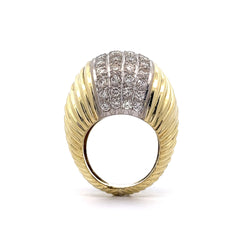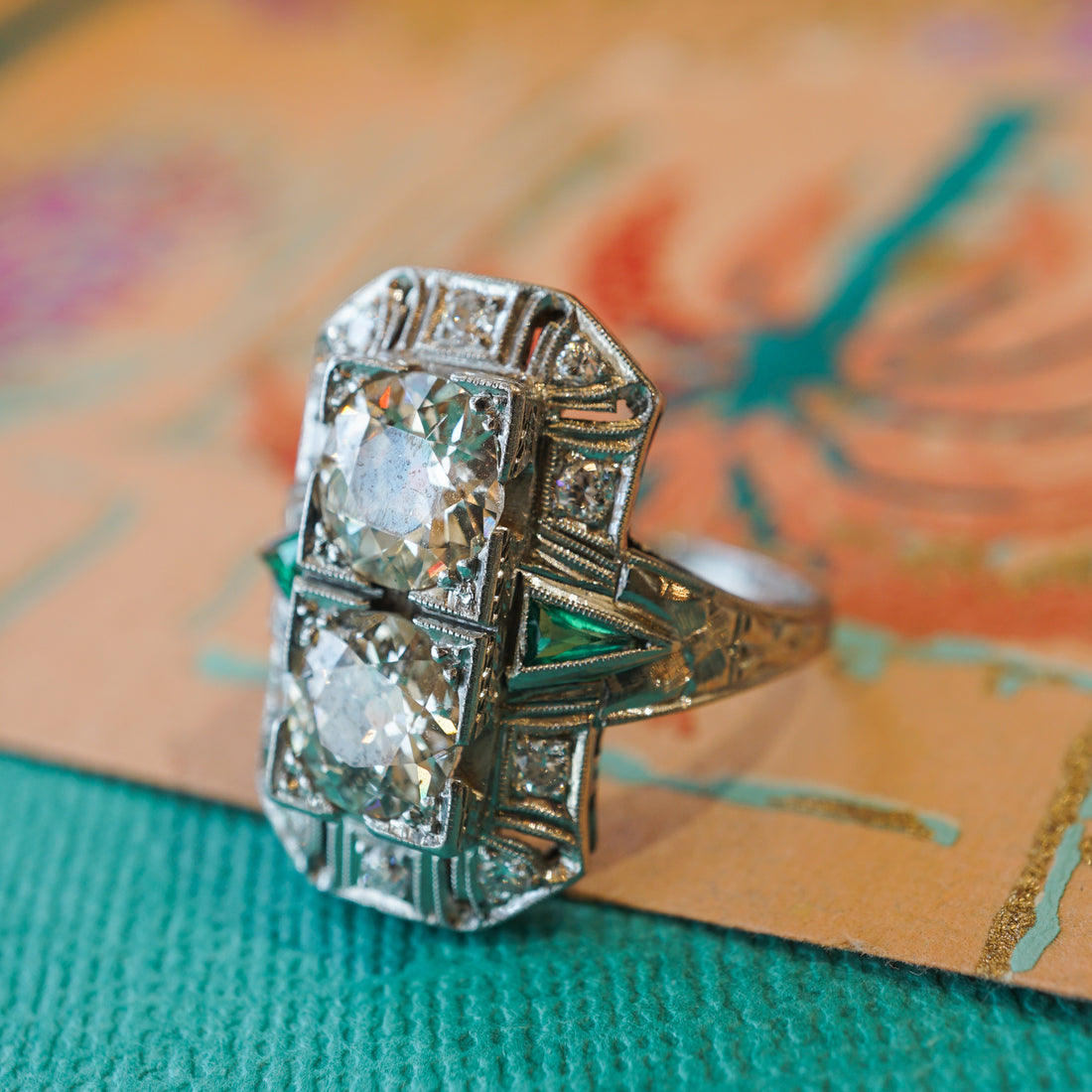
Making a Statement with Oversized Diamond Cocktail Rings
In the realm of fine jewelry, the magnificence of oversized diamond cocktail rings has etched an undeniable mark, seamlessly blending historical richness with the enchanting allure of precious stones and intricate designs. Through epochs and across generations, these sizable statement rings have signified not merely a fashion statement, but an emblem of audacious femininity and opulence, especially in spirited cocktail parties and sophisticated formal occasions. Let's take a look at the history of these style pieces and how that influences modern cocktail rings
The History of Cocktail Rings: Symbols of Rebellion and Elegant Defiance
Embark on a journey through time, where the luminous and audacious cocktail ring emanates tales of rebellion, empowerment, and splendid defiance. These rings, not merely accessories, have played a significant role in quietly protesting societal norms while becoming a beacon of feminine power and independence during a pivotal time in history.
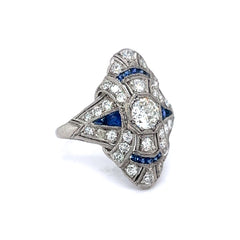
1.68 Art Deco Diamond & Sapphire Cocktail Ring in Platinum
The Prohibition Era and The Birth of a Symbol
The narrative of the cocktail ring unfolds during the Prohibition era in the 1920s, a period where the sale and production of alcoholic beverages were illegal in the United States. It was during this austere period that "cocktail rings" surfaced, not merely as extravagant adornments but as symbolic artifacts representing a silent rebellion against the constraints of the time. Women, daring and assertive, began to don these oversized rings, crafted meticulously with bold, colorful precious stones and diamonds, to illicit cocktail parties. Here, amidst the concealed revelry, the cocktail ring wasn’t simply a piece of jewelry. It was a subtle yet defiant nod against the restrictive norms, a glamorous protest where illegal drinking was embraced with silent rebellion and subdued elegance. Worn deliberately on the right hand—a stark contrast to the conventionally adorned wedding ring on the left—these rings signified more than rebellion. They became emblems of a woman’s economic independence and the burgeoning ideology that women could, and would, determine their destinies.
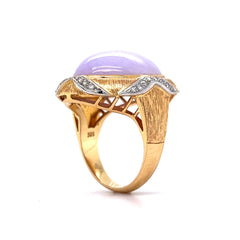
26.27 Lavender Jadeite Cabochon Cocktail Ring in 14k Yellow Gold
Mid-Century Resurgence: Cocktail Rings in the 1950s and 1960s
The 1950s and 1960s, celebrated in history for their vibrant cultural revolutions and distinctive style evolution, marked an important epoch for the cocktail ring, witnessing a resurgence and transformation into an emblem of opulence and social status.

Vintage Double Diamond Halo Turquoise Ring in 18k Yellow Gold
1950s: A Symbol of Post-War Prosperity
Post-World War II, the 1950s emerged as a period of economic boom and social change. Jewelry became larger, bolder, and more accessible as economies recovered and disposable income rose. Cocktail rings, with their large, oversized gems, particularly diamonds and other precious stones, embodied the newfound optimism and prosperity. It was an era where the prominence of bold jewelry, such as a lustrous diamond cocktail ring, paralleled the burgeoning indulgence in social and leisure activities. Cocktail parties became popular social gatherings, and the cocktail ring, once a symbol of rebellion, transitioned into a statement of wealth and elegance. Women adorned their fingers with these large, opulent rings, signaling not just a taste for luxury but a nod towards their continuing empowerment and growing prominence in social settings.
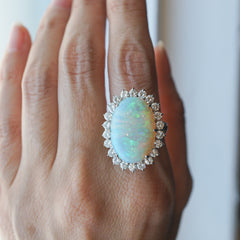
Vintage Opal & Diamond Cocktail Ring in 14k Gold
1960s: An Icon of Glamour and Liberation
As the world stepped into the 1960s, social, cultural, and fashion landscapes underwent significant shifts. Women’s liberation movements and a breakaway from traditional norms saw the cocktail ring evolving in its symbolic representation once more. During this period, the rings maintained their voluminous sizes but experimented with more colorful, whimsical, and innovative designs. Gemstones like blue topaz, emeralds, and sapphires, set in various metals such as yellow gold or platinum, reflected the era's experimental and revolutionary spirit. Iconic public figures like Elizabeth Taylor and Audrey Hepburn were frequently spotted adorning cocktail rings, further cementing their status as a staple in every fashion-conscious woman's jewelry collection. The cocktail ring became synonymous with the glitz and glamour of Hollywood, representing a blend of extravagance, style, and the burgeoning ideology that women could embrace and flaunt their own choices, both sartorial and societal.
4.16 Mid-Century Pave Diamond Cocktail Ring in 18k Yellow Gold
The Fashion Industry's Embrace Fashion
designers and jewelers of the mid-century played significant roles in promulgating the popularity of cocktail rings. Design houses and jewelers, such as Harry Winston and Cartier, began crafting signature cocktail rings that were not only seen as valuable accessories but also investments and heirlooms. Moreover, with the proliferation of television and media during this period, the visibility of cocktail rings became even more widespread. They were featured in movies, television shows, and advertisements, continuously associated with a blend of audacious style, luxurious living, and the ongoing narratives of women's evolving roles within society. The 1950s and 1960s weren’t just pivotal in shaping socio-economic and cultural norms but were instrumental in evolving the narrative and designs of cocktail rings. These decades firmly ensconced them as symbols of luxury, style, and empowered femininity, a legacy that still reverberates in the design and symbolic nuances of cocktail rings today. With their dazzling gems and bold designs, cocktail rings traversed through these transformative decades, encapsulating the changing times and continuing to shine as luminous snippets of history, society, and style, entwining fingers with stories from the spirited mid-century epoch.

Pave Diamond Flower Cocktail Ring 18k Yellow & White Gold
The Essence of Variety in a Jewelry Collection
Embarking on the rationale of assimilating an assortment of cocktail rings into your jewelry collection, it’s pivotal to recognize the versatility and statement that these pieces introduce to a wardrobe. A meticulously curated selection of cocktail rings, from vintage rings whispering tales of bygone glamour to modern creations echoing contemporary elegance, infuses a jewelry collection with diversity and a spectrum of styling options. A blue sapphire ring set in yellow gold, for instance, can accentuate the deep blues of an evening gown, while a delicate flower ring might lend a soft, romantic touch to a summer dress. The diamond ring, juxtaposed amidst colorful gemstones, elevates the regality and opulence of your collection, ensuring that you have the perfect piece to complement every occasion, outfit, and mood.
Inclusion as a Style Statement
Furthermore, the incorporation of cocktail rings extends beyond physical adornment, it’s an expression of individuality and style. Whether it’s the grandeur of a diamond cocktail ring lending an air of sophistication or a playful gemstone ring offering a splash of color, each piece reflects a facet of your personality and becomes a visual chronicle of your style journey. Oversized diamond cocktail rings, with their splendid history and enchanting aesthetics, undeniably deserve a place of honor in every jewelry collection. They are not merely accessories; they are storytellers, style enhancers, and timeless tokens that traverse generations, continually making statements and silently echoing the tales of times gone by.

